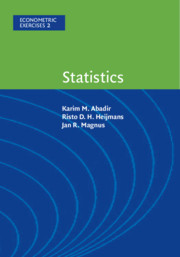Refine search
Actions for selected content:
37413 results in Cambridge Textbooks
Part II - The case stories
-
- Book:
- Case Learning for Teachers
- Published online:
- 01 April 2021
- Print publication:
- 18 June 2020, pp 63-218
-
- Chapter
- Export citation
7 - What does managing behaviour involve?
- from Part II - The case stories
-
- Book:
- Case Learning for Teachers
- Published online:
- 01 April 2021
- Print publication:
- 18 June 2020, pp 130-149
-
- Chapter
- Export citation
Additional material
-
- Book:
- Case Learning for Teachers
- Published online:
- 01 April 2021
- Print publication:
- 18 June 2020, pp ii-ii
-
- Chapter
- Export citation
2 - How best to interpret cases
- from Part I - Approaching the case stories
-
- Book:
- Case Learning for Teachers
- Published online:
- 01 April 2021
- Print publication:
- 18 June 2020, pp 26-44
-
- Chapter
- Export citation
Introduction: How best to use this book
-
- Book:
- Case Learning for Teachers
- Published online:
- 01 April 2021
- Print publication:
- 18 June 2020, pp 1-6
-
- Chapter
- Export citation

Statistics
-
- Published online:
- 11 June 2020
- Print publication:
- 08 November 2018
-
- Textbook
- Export citation
Author Biographies
-
- Book:
- Introducing Language in the Workplace
- Published online:
- 16 December 2020
- Print publication:
- 11 June 2020, pp xiii-xiv
-
- Chapter
- Export citation
11 - Possession and Title
-
- Book:
- Principles of Property Law
- Published online:
- 02 June 2020
- Print publication:
- 11 June 2020, pp 460-480
-
- Chapter
- Export citation
Index
-
- Book:
- Principles of Property Law
- Published online:
- 02 June 2020
- Print publication:
- 11 June 2020, pp 706-724
-
- Chapter
- Export citation
Chapter 8 - Culture and Language at Work
- from Part III - What about Identity and the Way This Is Enacted in the Workplace?
-
- Book:
- Introducing Language in the Workplace
- Published online:
- 16 December 2020
- Print publication:
- 11 June 2020, pp 211-236
-
- Chapter
- Export citation
Transcription Conventions
-
- Book:
- Introducing Language in the Workplace
- Published online:
- 16 December 2020
- Print publication:
- 11 June 2020, pp xxiii-xxiv
-
- Chapter
- Export citation
Part I - Introducing Language in the Workplace
-
- Book:
- Introducing Language in the Workplace
- Published online:
- 16 December 2020
- Print publication:
- 11 June 2020, pp 1-50
-
- Chapter
- Export citation
Part III - What about Identity and the Way This Is Enacted in the Workplace?
-
- Book:
- Introducing Language in the Workplace
- Published online:
- 16 December 2020
- Print publication:
- 11 June 2020, pp 157-236
-
- Chapter
- Export citation
Notes on Exercises
-
- Book:
- Introducing Language in the Workplace
- Published online:
- 16 December 2020
- Print publication:
- 11 June 2020, pp 263-268
-
- Chapter
- Export citation
Preface
-
- Book:
- Principles of Property Law
- Published online:
- 02 June 2020
- Print publication:
- 11 June 2020, pp xiii-xv
-
- Chapter
- Export citation
Part II - What Are Some Key Topics in Workplace Research?
-
- Book:
- Introducing Language in the Workplace
- Published online:
- 16 December 2020
- Print publication:
- 11 June 2020, pp 51-156
-
- Chapter
- Export citation
Acknowledgements
-
- Book:
- Principles of Property Law
- Published online:
- 02 June 2020
- Print publication:
- 11 June 2020, pp xvi-xvi
-
- Chapter
- Export citation
15 - Enforceability and Priority of Property Interests: General Principles
-
- Book:
- Principles of Property Law
- Published online:
- 02 June 2020
- Print publication:
- 11 June 2020, pp 552-588
-
- Chapter
- Export citation
7 - Objects of Property Interests
-
- Book:
- Principles of Property Law
- Published online:
- 02 June 2020
- Print publication:
- 11 June 2020, pp 264-326
-
- Chapter
- Export citation
Frontmatter
-
- Book:
- Principles of Property Law
- Published online:
- 02 June 2020
- Print publication:
- 11 June 2020, pp i-viii
-
- Chapter
- Export citation
